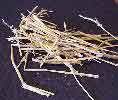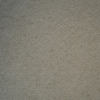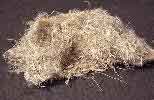TWINROCKER PAPERMAKING FIBERS |
 |
Labeled 1/8 lb. samples of each of the fibers we carry. These larger samples contain enough fiber to test and still leave enough to keep as a permanent reference. |
| Fiber Sampler | Shipping Wt.=1.75 lbs |
COTTON:
Cotton (botanical name Gossypium) is a strong, versatile fiber that comes in many forms. It is a
'seed hair' as it surrounds the seed in the cotton ball. When the cotton is ginned, the long
'staple' fibers are separated from the seeds, these fibers are Raw Cotton. Most of this fiber is
used to make cloth. It is cooked and cleaned. Cotton scraps from the garment industry are an
economical source for cotton rag, which we call Cotton Rag Half-Stuff, as it is ready for beating.
After ginning, the remaining seeds are covered with a fuzz of cotton fiber. When cut away from
the seeds, this is the source for cotton linters.
Cotton Linters: |
Cotton Rag: | Black Cotton: | Blue Cotton: |
1. COTTON LINTERS
Linters are the young cotton fibers closest to the seed. It can be made into any type of paper from
thick, absorbent sheets to thin, rattly ones; it is the primary fiber used for machine made 'cotton
content' paper. Cotton linters are relatively short with thick walls, when compared to cotton rag
or linen, and is particularly suited to thick, opaque papers. Available in two forms. Each bright
white in color:
1. COTTON LINTERS # 87
2. COTTON RAG This is 100% Staple Cotton that is called 'rag' because it is made from new garment cuttings. Staple cotton is a much longer fiber than linters and makes a stronger, harder sheet of paper that shrinks more in drying. It is well-suited for watercolor and book papers.
2a. COTTON RAG # 89
 |
A bleached cotton muslin that is warm white in color. Rag fiber is called half-stuff because it has been broken out of the cloth into near thread form. |
 |
Made from faded blue denim jeans the fiber has been pressed into sheets ready to beat into pulp. It will make a strong pulp for paper or can be added to other pulp as a decorative touch. |
HEMP:
Hemp has a long history as a papermaking fiber; it was as common as linen in Europe from the
14th to the 18th century. Hemp makes a very strong, rattly paper with high shrinkage.
HEMP HALF-STUFF:
TopRAW TOW FLAX:
 |
Golden wheat straw (raw) from the Brookston area of Indiana. It makes non-archival paper unless cooked in a caustic solution, which removes the impurities but leaves most of the color.
Note: As of August 16, 2017, Wheat Straw is only available in wet, ready-to-use pulp. |



